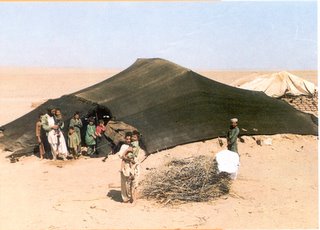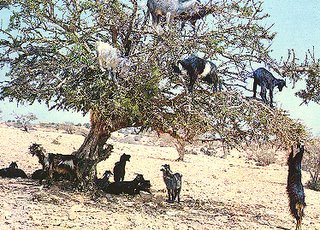Causes of desertification in Iran
Some causes of desertification in Iran are:
•Population growth:
The population of the country has doubled during the last 20 years and naturally the demand for agricultural and animal products have been increased proportionally to the rate of increase. Thus people were forced to increase the number of their livestock and to use the lands more extensively. In order to increase the area of agricultural lands, people converted the rangelands and forests into farms and croplands. They also cultivated marginal lands for rainfed crops without any consideration of their inherent potentials. These activities in many cases have resulted in desertification.
•Converting forests &rangelands into farmlands and increase of dry farming:
In the last decades extensive areas of rangelands located on the mountainous regions and steep slopes plowed and converted to the croplands and dry farming as the demand for cereals had increased. Since these kind of lands was not suitable for the agricultural practices soon after changed to a degraded land with very low productivity. Finally because of low productivity the land were abandoned and led to desetification processes
•Uncontrolled use of agricultural machinery:
Villagers and farmers can now obtain farm machinery easily. Most of these imported equipment do not fit the conditions of arid and semi-arid lands of Iran. These machinery not only let them much more extensive operations than traditional ones, but also are used to plow more rangelands and to cut more trees and bushes from the rangelands and forests.
•Fuelwood gathering:
Despite the fact that Islamic Republic of Iran is a rich country in oil well and oil industry, just a little portion of the villagers were able to use petroleum fuel before the Islamic revolution in 1979. In addition to the demand for fuel to meet household cooking and heating needs. In addition to the traditional fuel gathering some factories are also using fuelwoods.
•Refugees settlement:
During civil var. in Afghanistan both when Taliban governed and also during conflict between former Soviet and Mojahedin, many Afghan people left their country and settled in Iran and Pakistan as refugee. In Iran most of these refugees settled in the eastern part of Iran particularly in Khorasan and Systan Provinces. Excessive pressure exerted on land due to refugees activities to meet their requirement and demand for fuelwood caused more than 1.2 million hectares of lands being degraded.
•Overexploitation of water table and mismanagement of irrigation:
Overexploitation of ground water reserves for expansion of agricultural lands caused water table to drop to a critical level almost in the whole central plateau. As drought years persist, ground water table increasingly reused by stakeholders to meet their requirements in terms of irrigation and other needs. Since water table is not replenished in drought periods, thus resulted in aquifer deterioration and leads to land abundance. These processes finally resulted in desertification.
•Population growth:
The population of the country has doubled during the last 20 years and naturally the demand for agricultural and animal products have been increased proportionally to the rate of increase. Thus people were forced to increase the number of their livestock and to use the lands more extensively. In order to increase the area of agricultural lands, people converted the rangelands and forests into farms and croplands. They also cultivated marginal lands for rainfed crops without any consideration of their inherent potentials. These activities in many cases have resulted in desertification.
•Increase in the number of livestock: 
Increasing demand for dairy products during recent years has caused the increase in the number of livestock. In addition to overgrazing due to excessive livestock numbers, most of the rangelands experienced untimely grazing in the forms of early grazing or late grazing
•Converting forests &rangelands into farmlands and increase of dry farming:

In the last decades extensive areas of rangelands located on the mountainous regions and steep slopes plowed and converted to the croplands and dry farming as the demand for cereals had increased. Since these kind of lands was not suitable for the agricultural practices soon after changed to a degraded land with very low productivity. Finally because of low productivity the land were abandoned and led to desetification processes
•Uncontrolled use of agricultural machinery:

Villagers and farmers can now obtain farm machinery easily. Most of these imported equipment do not fit the conditions of arid and semi-arid lands of Iran. These machinery not only let them much more extensive operations than traditional ones, but also are used to plow more rangelands and to cut more trees and bushes from the rangelands and forests.
•Fuelwood gathering:

Despite the fact that Islamic Republic of Iran is a rich country in oil well and oil industry, just a little portion of the villagers were able to use petroleum fuel before the Islamic revolution in 1979. In addition to the demand for fuel to meet household cooking and heating needs. In addition to the traditional fuel gathering some factories are also using fuelwoods.
•Refugees settlement:

During civil var. in Afghanistan both when Taliban governed and also during conflict between former Soviet and Mojahedin, many Afghan people left their country and settled in Iran and Pakistan as refugee. In Iran most of these refugees settled in the eastern part of Iran particularly in Khorasan and Systan Provinces. Excessive pressure exerted on land due to refugees activities to meet their requirement and demand for fuelwood caused more than 1.2 million hectares of lands being degraded.
•Overexploitation of water table and mismanagement of irrigation:

Overexploitation of ground water reserves for expansion of agricultural lands caused water table to drop to a critical level almost in the whole central plateau. As drought years persist, ground water table increasingly reused by stakeholders to meet their requirements in terms of irrigation and other needs. Since water table is not replenished in drought periods, thus resulted in aquifer deterioration and leads to land abundance. These processes finally resulted in desertification.


1 Comments:
your observations are absolutely correct.
Post a Comment
Subscribe to Post Comments [Atom]
<< Home